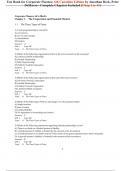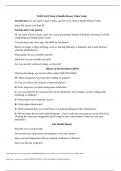Edition by Stephen A. Ross
Complete Chapter Solutions Manual
are included (Ch 1 to 32)
** Immediate Download
** Swift Response
** All Chapters included
** Excel Solutions
,Chapter 1: Introduction to Corporate Finance
Questions and Problems:
1.1 In the absence of agency problems, managers act in the best interest of shareholders and make
decisions to maximize shareholders’ wealth. They create value from the capital budgeting,
financing, and liquidity activities. For example, managers create value by buying assets that
generate more cash than they cost.
1.2 In the corporate form of ownership, the shareholders are the owners of the firm. The
shareholders elect the directors of the corporation, who in turn appoint the firm’s management.
This separation of ownership from control in the corporate form of organization is what causes
agency problems to exist. Management may act in its own or someone else’s best interests, rather
than those of the shareholders. If such events occur, they may contradict the goal of maximizing
shareholders’ wealth.
1.3 We would expect agency problems to be less severe in countries with a small percentage of individual
ownership. Fewer individual owners should reduce the number of diverse opinions concerning
corporate goals. The high percentage of institutional ownership might lead to a higher degree of
agreement between owners and managers on decisions concerning risky projects. In addition,
institutions may be better able to implement effective monitoring mechanisms on managers than can
individual owners, based on the institutions’ deeper resources and experiences with their own
management. The increase in institutional ownership of stock in the United States and the growing
activism of these large shareholder groups may lead to a reduction in agency problems for U.S.
corporations and a more efficient market for corporate control.
1.4 Canadian financial institutions include chartered banks and other depository institutions––trust
companies and credit unions as well as nondepository institutions––investment dealers, insurance
companies, pension funds and mutual funds.
Financial markets can be classified as either money markets or capital markets. Short–term debt
securities are bought and sold in money markets. Capital markets are the markets for long–term
debt and shares of stock, for example the TSX.
1.5 Canadian Financial Markets, like all markets, are experiencing rapid globalization. The toolkit of
available financial management techniques has expanded in response to a need to control volatility
risk and to track complex dealing in many countries. Computer technology improvements make
new financial engineering applications practical and create opportunities to combine different types
of financial institutions. Financial institutions pressure authorities to deregulate in a process called
the regulatory dialectic. Increased uncertainty during the COVID-19 pandemic and other disruptive
events led Canadian companies to delay their investments and to hold more cash for precautionary
motives. Unfortunately, several companies, particularly retailers, sought court protection from their
creditors.
These trends have made financial management in Canada much more complex and technical. In the
face of increased global competition and disruptive shocks, the payoff for good financial
management is great with finance becoming important in corporate strategic planning.
, Appendix 1A: Taxes
Questions and Problems:
1.A1 The average tax rate is total taxes paid divided by total taxable income whereas the marginal tax
rate is the extra tax payable on the next dollar earned.
1.A2 Personal investment income in the form of interest is taxed at the same rates as employment
income. Dividend income is initially taxed at the same rate as employment income but the dividend
tax credit reduces the effective tax rate on dividends for investors. Taxes on capital gains apply at
50 percent of the applicable marginal rate. However, before the 1994 Federal Budget, each
individual was entitled to receive a lifetime capital gains exemption of $100,000
net of any capital losses. From a corporate point of view, interest earned is fully taxable while
dividends on common shares of other Canadian corporations are received tax–free. As with
individuals, capital gains are taxed at 50 percent of the marginal rate.
1.A3 If the firm has an operating loss, it may be carried back to reduce net income in the three prior years
and carried forward for up to twenty years. In the case of capital losses, if capital losses exceed
capital gains, the net capital loss may be carried back to reduce taxable capital gains in three prior
years and carried forward indefinitely. An investment tax credit allows a qualified firm to subtract a
set percentage of an investment directly from taxes payable.
1.A4 a. Ontario
Corporation X: Taxes = .122 x $100,000 = $12,200
Corporation Y: Taxes = .265 x $1,000,000 = $265,000
b. The firms have different marginal tax rates. Firm X pays (0.122 x $10,000) = $1,220 more
and Firm Y, pays an additional (0.265 x $10,000) = $2,650.
1.A5
DIVIDENDS
Dividend $10,000.00
Gross up (38%) 3,800.00
Grossed–up dividends 13,800.00
Federal Tax (33%) 4,554.00
Less Federal Dividend Tax Credit (.150198 x $13,800) 2,072.73
Federal Tax Payable 2,481.27
Provincial Tax (.1316 x $13,800) 1,816.08
Less Provincial Tax credit (.1 × $13,800) 1,380.00
Provincial Tax Payable 436.08
Tax Payable 2,917.35










